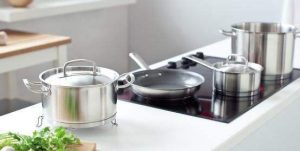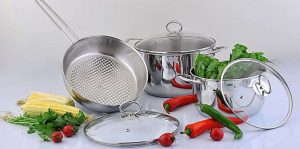Types and inspection points of stainless steel kitchenware

Stainless steel kitchen utensils: including three parts: handle, body and neck;
Handle: stainless steel kitchenware holding part by hand;
Main body: Stainless steel kitchenware is collectively referred to as the main body except for the handle part;
Neck: The connecting part (welding point) between the handle of stainless steel and the head is called the neck.
Product classification: Stainless steel kitchen utensils are divided into spoons, shovels, clips, and screens according to their functions.
1. Spoons: Mainly divided into: colander, soup spoon, lifting spoon, rice spoon, tongue spoon, noodle spoon, measuring spoon and so on.
2. Shovel category: Mainly divided into: flat shovel, pan shovel, leak shovel, cake shovel, tamping shovel and so on.
3. Clip (sub) holding categories: mainly divided into: grasping clips, sawtooth clips, disk picking and so on.
4. Mesh sieve category: Mainly divided into: oil separator, rice basket, rice washing sieve, etc. (Note: “oil separator” is also called “sand fence”).
5. Metal materials: The stainless steel materials of kitchen utensils should meet the food hygiene requirements.
6. The structure of kitchen utensils should be able to be thoroughly cleaned to avoid secondary contamination of food.
7. Appearance requirements: The product should be basically straight and symmetrical, unless the design requires non-straightness or asymmetry.
8. A batch of products should not have significant changes in form and size.
9. The trademark of the appearance of the product should be correct, the position should be consistent, the handwriting should be clear, and it should meet the product labeling requirements.
10. The surface of the product is smooth, and there are no burrs on the edges.
11. The neck should be smooth and clean, without surfacing, virtual welding, air holes, cracks. The surface of the main body of the product is allowed to have defects less than 0.5mm in diameter, but it cannot exceed four points within 20 cm2. The surface of the main body of the product is allowed to have one scratch less than 20mm in length, and no more than two scratches less than 10mm.
12. Inspection of stainless steel kitchenware: The appearance, surface roughness, neck surface, flaws, surface scratches, corrosion resistance, permanent deformation, tensile strength, torque resistance, drop resistance, air tightness, plastic handle of stainless steel kitchenware need to be checked Resistance to thermal deformation, high temperature softening of plastic handles, resistance to environmental stress cracks, neck fatigue strength, hygienic requirements.
Inspection method of stainless steel kitchenware

Appearance inspection: The appearance inspection of products shall be inspected by hand and visual inspection under normal light. The surface roughness inspection of stainless steel body shall be in accordance with GB / T10610 (the surface roughness shall be inspected by comparison inspection).
Corrosion resistance test
2. Fastness test
3. Permanent deformation test: place the test piece on a horizontal plane with the highest point of the neck of the handle facing upwards, apply a force of 7N per centimeter or 150N excluding the length, and the time of the force is 10S. Permanent deformation allowed at the point of force can be measured with a dial indicator.
4. Tensile and torsion test: Immerse the kitchenware in water at 100 Celsius + 5 Celsius for 10min, and then immediately propose that the tensile and torque tests should be performed on the same test piece in sequence.
5. Drop test
The kitchenware was vertically downward with the handle, dropped from a height of 1m to the concrete floor, and was continuously dropped 5 times, and then the kitchenware was dropped 5 times in the horizontal direction.
6. Thermal deformation test of plastic handle
The plastic handle kitchenware was immersed in water at a temperature of 80 Celsius for 30 minutes.
7. High temperature resistance softening test of plastic handle
The main body of the product is placed in water in a pot maintained at 100 Celsius ± 4 Celsius, and any part of a plastic handle made of the same material is placed on a pot side heater. The heater is kept at a constant temperature of 110 Celsius ± 2 Celsius for 6 minutes.
8. Environmental stress crack resistance test of plastic handle
A. Dip the plastic handle of the kitchenware evenly into the mixed solution of toluene and n-propanol (1: 3 volume ratio), and keep it at 22 Celsius ± 4Celsius for 24h.
B. Should withstand the following 30 cycles.
Store the plastic handle in water at 70 Celsius ± 1 Celsius for 15 minutes, then immediately transfer it to the freezer of the refrigerator and keep it at -18 Celsius ± 1Celsius for 3 h. Then immediately return the handle to hot water. Go to restart the next cycle.
After the last cycle test, the sample should be calibrated to an indoor temperature of at least 15 Celsius. The tested sample is checked under a microscope or a 4x magnifier.
9. Neck fatigue strength test
Follow the test steps below, after 150 repetitions
A. Fix the product handle on the fixed fixture, the main body is fixed on the movable fixture, the fixed fixture with the nearest contact point between the movable fixture and the main body, the clamping block spacing is 90mm ± 1mm Clamping additional stress);
B. With the main body of the product centered on the neck, at a movement rate of 17 times / min, move downward at a uniform speed of 30mm ± 1mm and then reset at a constant speed (30mm downward movement is the first movement, and uniform speed is reset to the second movement. ).